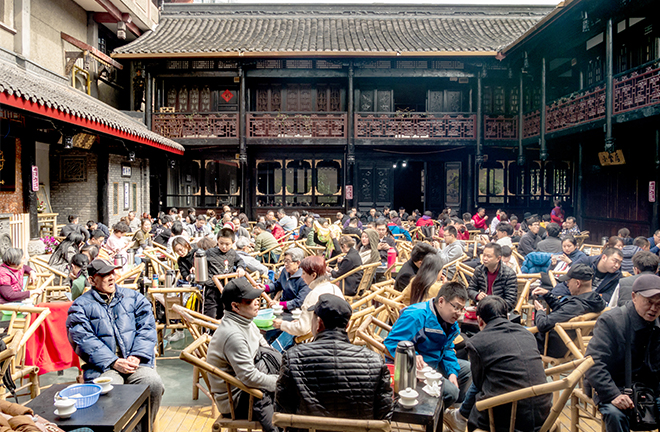History of popular culture from an interdisciplinary perspective

Research on the cultural history of teahouses has advanced notably in recent years. Photo: TUCHONG
Since the turn of the century, the history of popular culture, an important branch of the new cultural history, has shifted its focus from traditional studies on the upper class and elite culture to examining the everyday lives of ordinary people and popular culture, giving rise to numerous new research areas and directions. The diversification of research on the history of popular culture calls for the integration of multidisciplinary theories and methods, as well as the support of big data and artificial intelligence.
Diverse research subjects
Scholars apply theoretical frameworks such as the state and society, civil society, and public space to study the history of popular culture at macro, meso, and micro levels. These studies, framed through perspectives on social structure, social classes, and governance, have given rise to fields like the histories of communication culture, wine culture, tea culture, theater culture, park culture, consumer culture, and street culture. These emerging areas supplement and expand traditional disciplines, including political, economic, diplomatic, military, and intellectual histories.
China’s vast territory and pronounced regional differences have resulted in an array of distinct popular customs and lifestyles. The history of popular culture analyzes the underlying social and political implications of popular cultural activities and daily behaviors from the perspective of clothing, food, housing, transportation, and intellectual life. Breakthroughs have been made in areas such as the cultural history of residential architecture, the history of the spatial evolution of consumer culture, women’s cultural history, the history of popular religious beliefs in the context of Chinese-Western cultural conflicts, and the cultural history of teahouses.
Examining the rich and colorful life of popular culture enables researchers to gain insights into the historical drivers behind its formation, the relationship between popular and elite cultures, and the complex entanglements between popular culture and state power. Scholars explore the intellectual underpinnings of popular culture and analyze the social environment and social relations it mirrors. With the advancement of industrialization and urbanization in modern China, the urban population has grown substantially. Amid the fusion of tradition and modernity, the content, spatial distribution, modes of transmission, and characteristics of urban popular leisure and entertainment have become key research subjects in the history of popular culture.
Interdisciplinary integration
Since the beginning of the 21st century, China has hosted several international interdisciplinary academic conferences and workshops on the history of popular culture. The first, second, and third International Symposiums on the History of Urban Popular Culture in Modern China were held respectively in Shanghai, Chengdu, and Wuhan. Scholars from the China, the US, and Japan engaged in lively discussions on topics such as “Theater, Film, Literature, and Urban Entertainment Spaces,” “Economic Life and Lower Classes in Early Modern Cities,” “Political Changes and Urban Culture Evolution,” “Street Culture and Public Politics,” and “Politics of Entertainment and Major Historical Events.” These conferences promoted the integration of the history of popular culture with the theories and methodologies of related disciplines, not only outlining the historical trajectory of popular culture, but also capturing its essence and depicting the various aspects of people’s everyday cultural life.
Scholars of the history of popular culture should actively integrate the theories and methods of multiple disciplines, facilitating the integration of historical studies with anthropology, sociology, architecture, literature, medicine, religious studies, communication studies, and information science to enhance interdisciplinary collaboration and innovation. Moreover, comprehensive use of diverse materials—including archives, folk literature, oral histories, inscriptions, images, and videos—should be encouraged to ensure these resources complement one another.
Empowered by new technologies
The rapid rise of new technologies such as big data and artificial intelligence has revolutionized how historians collect, organize, and utilize data, expanding their analytical frameworks and transforming the presentation of research findings. These advancements have created unprecedented opportunities for historical studies. By digitizing vast quantities of paper documents through scanning and photography, scholars can extract and standardize information for deep analysis, modeling, and the construction of databases that integrate texts, images, and maps. Advanced technologies can also be used to integrate various resources in the history of popular culture and build platforms for interdisciplinary collaboration and exchange, which helps optimize disciplinary resources and break down communication barriers between disciplines. Cross-institutional, cross-field, and cross-regional collaboration is crucial for achieving meaningful interdisciplinary research.
Tan Yuxiu is a professor from the School of History and Culture at Northeast Normal University.
Edited by WANG YOURAN

 PRINT
PRINT CLOSE
CLOSE